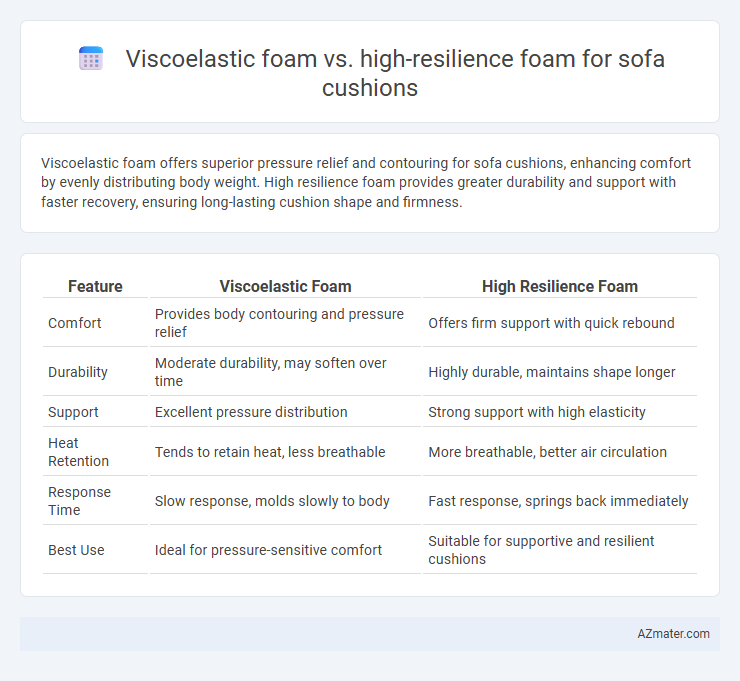Viscoelastic foam offers superior pressure relief and contouring for sofa cushions, enhancing comfort by evenly distributing body weight. High resilience foam provides greater durability and support with faster recovery, ensuring long-lasting cushion shape and firmness.
Table of Comparison
| Feature | Viscoelastic Foam | High Resilience Foam |
|---|---|---|
| Comfort | Provides body contouring and pressure relief | Offers firm support with quick rebound |
| Durability | Moderate durability, may soften over time | Highly durable, maintains shape longer |
| Support | Excellent pressure distribution | Strong support with high elasticity |
| Heat Retention | Tends to retain heat, less breathable | More breathable, better air circulation |
| Response Time | Slow response, molds slowly to body | Fast response, springs back immediately |
| Best Use | Ideal for pressure-sensitive comfort | Suitable for supportive and resilient cushions |
Introduction to Sofa Cushion Foams
Viscoelastic foam, commonly known as memory foam, provides excellent pressure relief and contouring support by responding to body heat and weight, making it ideal for sofa cushions that prioritize comfort and ergonomic support. High resilience foam offers superior durability and resilience with a fast recovery rate, ensuring long-lasting cushioning and consistent support for frequent use. Choosing between viscoelastic and high resilience foam depends on the desired balance between softness, durability, and support in sofa cushions.
What Is Viscoelastic (Memory) Foam?
Viscoelastic foam, commonly known as memory foam, is a type of polyurethane foam infused with viscoelastic chemicals that allow it to contour closely to the body's shape by responding to heat and pressure. This foam provides superior cushioning by evenly distributing weight, reducing pressure points, and offering enhanced comfort and support for sofa cushions. In contrast, high resilience foam is more buoyant and responsive, maintaining its shape with quicker recovery times but lacking the deep contouring properties of viscoelastic foam.
Understanding High Resilience (HR) Foam
High Resilience (HR) foam offers superior durability and support compared to viscoelastic foam, making it an ideal choice for sofa cushions that require long-lasting comfort and shape retention. HR foam features an open-cell structure that promotes better air circulation, enhancing breathability and preventing heat buildup during extended use. Its quick response to pressure ensures consistent firmness and resilience, providing ergonomic support that adapts to body movements without sagging over time.
Comfort and Support Comparison
Viscoelastic foam, also known as memory foam, offers superior contouring comfort by distributing body weight evenly and reducing pressure points, making it ideal for those seeking personalized cushioning. High resilience foam provides enhanced support with quicker response and higher durability, maintaining sofa shape and promoting better posture over extended use. The comfort of viscoelastic foam focuses on softness and adaptability, while high resilience foam excels in resilience and long-term structural support.
Durability and Longevity
Viscoelastic foam offers excellent pressure relief but tends to have lower durability compared to high resilience foam, which maintains its shape and firmness over extended use. High resilience foam features a more robust cellular structure that supports frequent compression and decompression cycles without significant breakdown, leading to longer-lasting sofa cushions. Choosing high resilience foam for sofa cushions ensures superior longevity and consistent comfort, making it a preferred option for durability-focused upholstery.
Breathability and Temperature Regulation
Viscoelastic foam offers superior contouring and pressure relief but tends to retain heat due to its dense cell structure, resulting in limited breathability and less effective temperature regulation. High resilience (HR) foam features an open-cell structure that promotes better airflow, enhancing breathability and maintaining a cooler surface temperature during prolonged seating. Choosing HR foam cushions is ideal for environments where temperature regulation and ventilation are prioritized to prevent heat buildup and improve comfort.
Allergen and Odor Considerations
Viscoelastic foam, known for its dense structure and ability to trap dust mites, may pose challenges for allergy sufferers if not regularly cleaned, while its slow off-gassing can result in a temporary odor upon initial use. High resilience foam offers better breathability and faster recovery, reducing moisture build-up that can harbor allergens, and typically emits less odor due to its open-cell structure. Both foams benefit from hypoallergenic covers and proper ventilation to minimize allergen accumulation and unpleasant smells in sofa cushions.
Price Differences and Value
Viscoelastic foam, commonly known as memory foam, typically commands a higher price due to its superior pressure relief and contouring properties, enhancing comfort and durability in sofa cushions. High resilience foam offers a more affordable alternative with excellent support and better bounce, making it ideal for budget-conscious consumers seeking long-lasting firmness. The value in viscoelastic foam lies in enhanced comfort and body adaptation, while high resilience foam delivers cost-effective resilience and shape retention over time.
Best Use Cases for Each Foam
Viscoelastic foam, known for its superior pressure relief and body contouring properties, is best suited for sofa cushions in environments where comfort and support during extended seating are priorities, such as home theaters or relaxation areas. High resilience foam offers excellent durability and bounce, making it ideal for frequently used sofas in family rooms or commercial spaces where long-lasting, responsive cushioning is essential. Choosing between viscoelastic and high resilience foam depends on whether the primary use emphasizes comfort and pressure distribution or resilience and shape retention.
Which Foam Should You Choose for Your Sofa?
Viscoelastic foam, also known as memory foam, offers superior pressure relief and contouring support, making it ideal for those seeking comfort and pain reduction in sofa cushions. High resilience foam provides greater durability and bounce, maintaining its shape longer under frequent use and offering firm, supportive seating. Choose viscoelastic foam for enhanced comfort and body conformity, while high resilience foam is better suited for long-lasting, resilient sofa cushions with consistent support.

Infographic: Viscoelastic foam vs High resilience foam for Sofa cushion
 azmater.com
azmater.com